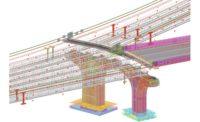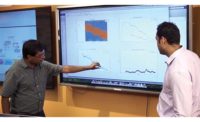
Bridge monitoring and assessment tools are proliferating, from strain gauges to ultrasound bridge pins, infrared systems and sound monitors. And while researchers are constantly improving monitoring methodologies, engineers note that these tools only supplement the trained eyes of experts' visual inspections.
Jeff Matros, president of STRAAM Corp., says bridges have been the slowest-moving structural market for sensor technology. This technology requires the use of only two or three accelerometers for less than a day to get a baseline evaluation (ENR 1/17/11 p. 32), he notes, saying,"We get called in when it's heart-critical,not heart-preventative."
Many owners are willing to experiment. Lee Floyd, a South Carolina Dept. of Transportation maintenance engineer, says the agency saved $700,000 thanks to 20 sensors provided by LifeSpan Technologies. The sensors provided evidence a bridge was in a better-than-expected condition. "We thought we might have to do extensive repairs just to keep it open," Floyd says. The sensors also verified that SCDOT could delay another $10-million replacement for at least five years, he adds.
Sensor technology suppliers abound. KESTA Corp., a firm funded by South Korea's highway agency, recently set up shop in Los Angeles. KESTA is courting bridge owners with the so-called SMART method, using wireless accelerometers placed along the bridge lanes' edges. Without shutting down traffic, the sensors collect ambient vibration data and update the test's original finite model. Brian Merrill, a bridge division manager with the Texas Dept. of Transportation, noted, "We've got a few bridges that have odd configurations or unique, one-off designs. That's where this shows the most promise."
Tom Styrbiki, bridge inspection program manager for the Minnesota Dept. of Transportation, says that, along with other advanced methods such ultrasonic tests, acoustic emissions monitoring and thermography, the method can serve "as a tool for some bridges where standard results aren't enough." He adds, "It's nice to have all these options that are becoming affordable and producing results, but visual inspection is still the bread and butter."
Advances in visual inspection include a specialized inspection system for cable stays. "Some of our clients are buying into full, hands-on inspections of cables," says Mike Januszkiewicz, associate with Modjeski and Masters. Rather than closing down lanes, M&M crews can rappel off a cable in controlled, arbitrary intervals on a roller system that has wheels and axles. "We can look at all sides of the cable, and we use lasers down to the deck to get the elevations and coordinates," he says.
Efforts to assess cable strength are evolving. Khaled Mahmoud, president of Bridge Technology Consulting, recently patented a random-sampling method that is used to evaluate crack growth rates in bridge cable wires using a degradation prediction model.
"The inspection of cables is pretty tricky," says Ted Galambos, emeritus civil engineering professor at the University of Minnesota and a peer reviewer of the method. "Khaled improved on the [standard] process and made it a whole lot more inclusive but also more expensive. His method is principally combining field investigation, taking out pieces and wires, and sending them to several labs to do material tests and fracto-graphic tests."
Mahmoud's method and the acoustical measurements that pick up the sounds of breaking cable wires are useful improvements. However, "you still have to have rational assessments of what that data means," says John Fisher, founder of Lehigh University's ATLSS Center. "I don't think anybody is going to have a measurement that picks up crack growth any sooner than you would be able to see it visually."
Meanwhile, Iowa and Minnesota DOTs are among the states pushing to create system-wide, risk-based bridge management systems based on advanced software programs, such as Bentley's InspectTech, that streamline and customize bridge data into a one-stop shop. MnDOT is investing in the next version of AASHTO's Pontis software program, says Styrbiki. "If it ultimately proves better than our version, we'll go with that."




Post a comment to this article
Report Abusive Comment